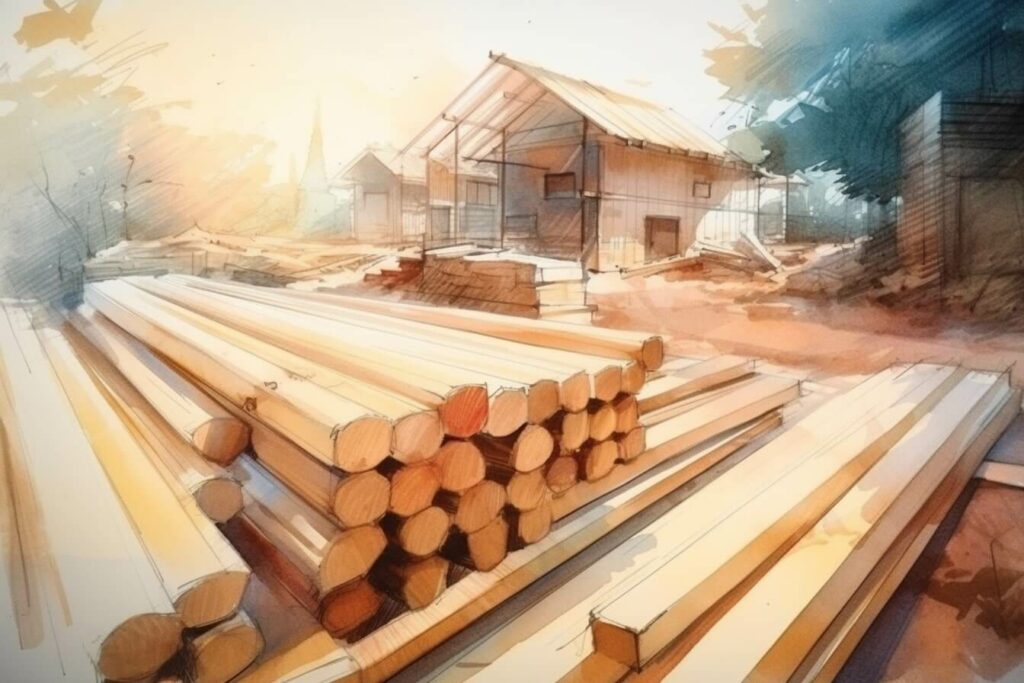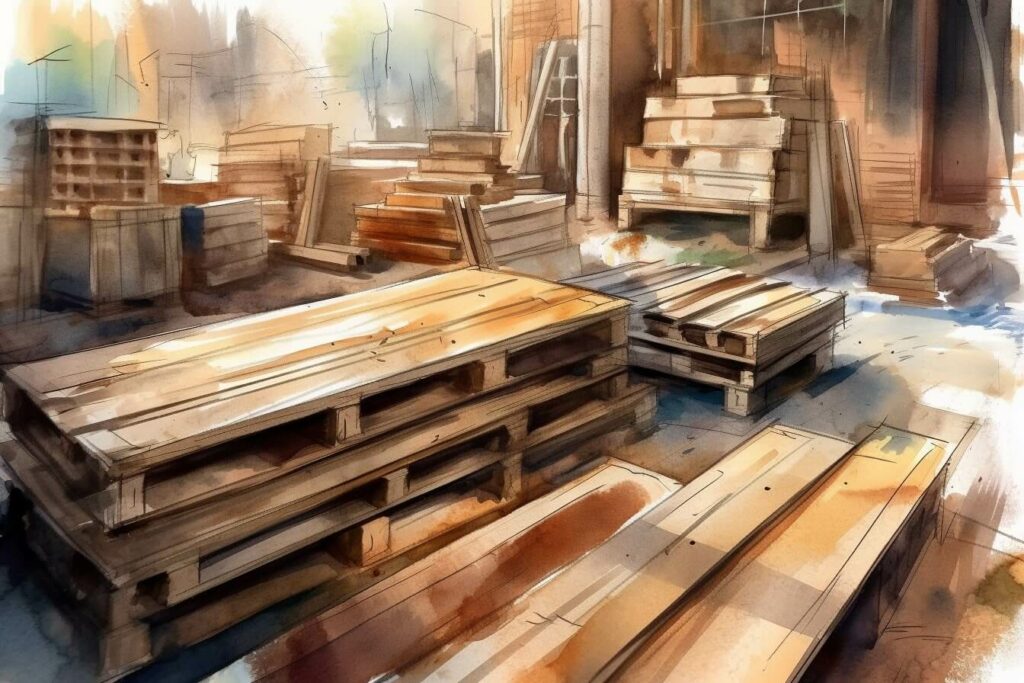



A 2-day immersion into the future of sustainable construction
Have you ever wondered how you could contribute to a greener environment while designing or constructing a new project? If so, you might have encountered the term “sustainable wood.”
This article will investigate sustainable wood’s importance, characteristics, types, and role in construction and design. So, let’s embark on this eco-friendly journey together!


The Importance of Sustainable Wood
Environmental Benefits
Ecological wood helps preserve forests, biodiversity, and natural habitats. We can prevent deforestation and promote reforestation by ensuring proper forest management and the responsible sourcing of wood. Sustainable wood also helps reduce carbon emissions by acting as a carbon sink and encourages using environmentally-friendly processing methods.
Social Benefits
Sustainable wood promotes fair labor practices and improved working conditions for those employed in the forestry sector. It also supports local communities that rely on forests for their livelihood and contributes to their overall well-being.
Economic Benefits
Sustainable wood can create new markets and provide economic incentives for responsible forestry practices. It can also lead to cost savings in the long run by reducing waste and promoting resource efficiency.
Characteristics of Sustainable Wood
Sustainable wood, also known as ecological or eco-wood, possesses distinct characteristics that make it an environmentally responsible choice.
These characteristics include being sourced from well-managed forests, legally harvested, processed using environmentally-friendly methods, and having a long lifespan with enhanced durability. Let’s explore these characteristics in more detail:
Sourced from Well-Managed Forests
Ecological wood comes from forests that adhere to responsible management practices, ensuring the preservation of ecosystems, biodiversity, and overall forest health. Forest management practices that promote sustainability include:
- Selective logging: This practice involves carefully removing individual trees or small groups of trees, leaving most of the forest intact. This method maintains the forest’s ecological balance and allows for natural regeneration.
- Reduced-impact logging (RIL): RIL minimizes the environmental impact of logging operations by using techniques such as directional felling, proper road construction, and efficient use of machinery. This approach helps reduce soil erosion, damage to remaining trees, and disturbance to wildlife.
- Continuous cover forestry (CCF): CCF promotes the maintenance and enhancement of forest cover through selective tree removal and natural regeneration. This approach creates a diverse, multi-aged, and resilient forest ecosystem.
Legally Harvested
Ecological wood is harvested in compliance with local and international laws and regulations. Legal harvesting ensures that forests are managed sustainably and that the rights of local communities and indigenous peoples are respected.
By choosing legally harvested wood, you contribute to the fight against illegal logging, which has severe environmental, social, and economic consequences, such as deforestation, loss of biodiversity, and revenue losses for governments.
Environmentally-Friendly Processing
Eco-wood undergoes processing methods that minimize harmful chemicals and reduce waste. Environmentally-friendly processing techniques include:
- Water-based adhesives: These adhesives are less toxic and produce fewer volatile organic compounds (VOCs) than solvent-based alternatives, making them a better choice for the environment and indoor air quality.
- Low-VOC finishes: Low-VOC finishes release fewer harmful emissions into the atmosphere and indoor spaces. Using low-VOC finishes on eco-wood products helps contribute to a healthier indoor environment and reduces air pollution.
- Eco-friendly materials: Sustainable wood products often incorporate other eco-friendly materials, such as recycled or reclaimed metal, glass, or plastic. This helps reduce waste and the consumption of non-renewable resources.
Longevity and Durability
Ecological wood is often more durable and long-lasting compared to non-sustainable alternatives. Its inherent strength and resilience make it suitable for various applications, from structural components to furniture and decorative elements.
Products made from eco-wood have a longer life, reducing waste and the need for frequent replacements. This longevity also contributes to cost savings in the long run, as durable products require less maintenance and repair over time.
Types of Sustainable Wood
Several types of sustainable wood are available, each with unique characteristics and advantages. By choosing one of these eco-friendly options, you can contribute to responsible forest management and minimize your environmental impact. Let’s explore these types of sustainable wood in more detail:
FSC-Certified Wood
The Forest Stewardship Council (FSC) is an international non-profit organization that certifies wood products sourced from well-managed forests. FSC-certified wood is a reliable indicator of sustainable wood, ensuring responsible forest management practices. The FSC certification process thoroughly assesses the entire supply chain, from the forest to the final product. FSC-certified wood comes in various species, such as oak, maple, and pine, making it suitable for various applications.
PEFC-Certified Wood
The Programme for the Endorsement of Forest Certification (PEFC) is another international non-profit organization that promotes sustainable forest management. Like FSC, PEFC certification ensures that wood products are sourced from responsibly managed forests. Although FSC and PEFC have different certification standards, both are widely recognized and accepted as reliable indicators of sustainable wood.
Reclaimed Wood
Reclaimed wood is salvaged from old buildings, barns, and other structures slated for demolition. Using reclaimed wood is an excellent way to give a second life to valuable materials, reducing waste and the need for new raw materials. Reclaimed wood has a unique character and appearance, often featuring weathered textures, nail holes, and other signs of age. This adds a rustic, vintage appeal to furniture, flooring, and other design elements. Reclaimed wood also comes in various species and dimensions, providing many options for creative applications.
Bamboo
Bamboo is a fast-growing, renewable resource that can be harvested without causing harm to the environment. Technically a grass, bamboo grows much faster than traditional hardwood trees, reaching maturity in 3-5 years. Its rapid growth rate makes it a popular sustainable wood alternative due to its strength, durability, and versatility in various applications. Bamboo can be used for flooring, furniture, cabinetry, and structural components. It is also naturally resistant to moisture and insects, making it a durable and low-maintenance material.
Other Certified and Sustainable Wood Alternatives
Several other organizations and certifications promote sustainable wood and wood alternatives. Some examples include:
- CITES (Convention on International Trade in Endangered Species): CITES regulates the international trade of endangered species, including certain types of wood. Using CITES-approved wood ensures that the material is legally sourced and does not contribute to the decline of threatened species.
- Salvaged wood: Similar to reclaimed wood, salvaged wood is sourced from fallen trees due to natural causes, such as storms, disease, or old age. By using salvaged wood, you can help reduce waste and prevent the need for new logging.
- Plantation wood: Plantation wood is grown on tree farms specifically for harvesting. These plantations often follow sustainable management practices and can help reduce the pressure on natural forests. Plantation wood can include species like teak, eucalyptus, and rubberwood.
By choosing one of these sustainable wood options, you can contribute to a healthier environment while adding a unique, eco-friendly touch to your projects.
Sustainable Wood in Construction and Design
Green Building Certification Programs
Ecological wood is crucial in green building certification programs like LEED, BREEAM, and WELL. These certifications encourage using eco-friendly materials and practices in the construction industry, ultimately contributing to a more sustainable built environment.
Sustainable Design Principles
Incorporating sustainable wood into your projects aligns with sustainable design principles such as reducing waste, promoting energy efficiency, and using locally-sourced materials. It also helps create healthier indoor environments by minimizing harmful chemicals and reducing air pollution.


Sustainable Wood: A Conclusion
Ecological wood is an essential component of eco-friendly design and construction practices. It offers numerous environmental, social, and economic benefits while promoting responsible forestry and resource management. Choosing ecological wood for your projects contributes to a greener and more sustainable future.
FAQs
What makes wood sustainable?
Ecological wood is sourced from well-managed forests, legally harvested, processed using environmentally-friendly methods, and is known for its longevity and durability.
How can I ensure the wood I use is sustainable?
Look for certifications such as FSC or PEFC, which indicate responsible forest management practices. You can also choose reclaimed wood or sustainable alternatives like bamboo.
Why should I choose sustainable wood over non-sustainable alternatives?
Ecological wood helps protect forests, biodiversity, and natural habitats while promoting fair labor practices and providing economic incentives for responsible forestry.
Can sustainable wood be used in all construction and design applications?
Ecological wood can be used for various applications, including structural components, flooring, cabinetry, furniture, and decorative elements.
Does sustainable wood cost more than non-ecological wood?
While eco-wood may sometimes come with a higher upfront cost, it can lead to long-term savings due to its durability, longevity, and reduced waste.
Now that you’ve learned about sustainable wood and its benefits, we invite you to discover UGREEN certification for early-design sustainable projects.
Discover affordable, exceptional, and environmentally-conscious designs from the inception of your project through our innovative early-design process certification that inspires mindful creativity.






A 2-day immersion into the future of sustainable construction
If you need our services in the Portuguese language, click here.

